SEO
The Only Guide You Need
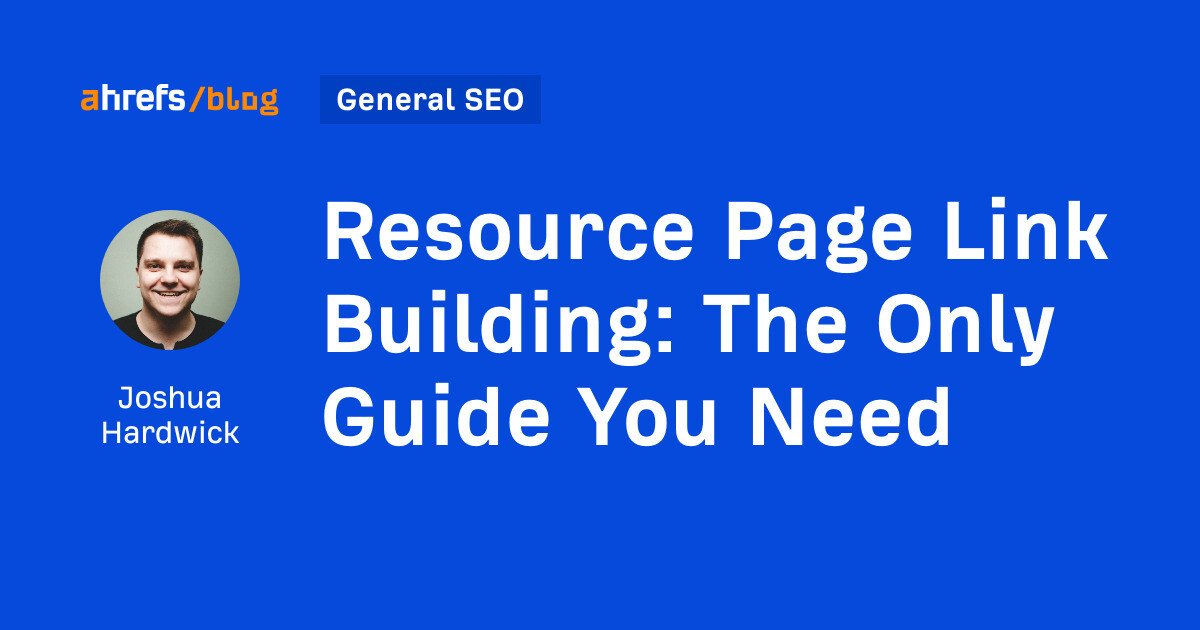
Resource page link building is nothing new, but it remains a popular link building tactic.
How popular? According to Aira’s 2022 State of Link Building Report, 24% of SEOs use it:

Here are three reasons why:
- It works.
- It’s scalable.
- It’s relatively easy.
In this guide, I’ll explain how to build links from resource pages in three simple steps.
But first, let’s make sure we’re on the same page.
Resource page link building is where you get backlinks from webpages that curate and link out to useful industry resources.
Here’s what a typical resource page looks like:

If you have a great design resource, you can reach out to the creator of that page and suggest it for inclusion.
Suggesting a useful resource to a resource page owner helps keep the page fresh and up to date. That’s why many of their creators actually ask for submissions.

This means you don’t have to do too much convincing to get useful resources added.
You’ll first need a useful resource to pitch. This can be your homepage. But in most cases, it’ll be an informational resource or interactive tool. If you don’t have that, read our guide to creating link bait.
If you’re good to go, follow this process:
- Find relevant resource pages
- Vet the pages
- Reach out and suggest your resource
1. Find relevant resource pages
The easiest way to do this is with Google search operators.
To set yourself up for success, start by doing these three things:
- Create a free Ahrefs Webmaster Tools account
- Install Ahrefs’ SEO Toolbar
- Go here and set the number of Google search results per page to 100
Next, head back to Google and type a broad keyword related to your resource followed by this search operator: intitle:resources inurl:resources.html.
For example, if your resource is a keto diet calculator, you may search for this:

Next, click the SEO Toolbar icon in your browser and toggle “SERP tools” on, as well as “Results metrics” under the SERP settings.

You should now see an Ahrefs overlay in the Google search results with an “Export CSV” button. Click this to export the results.
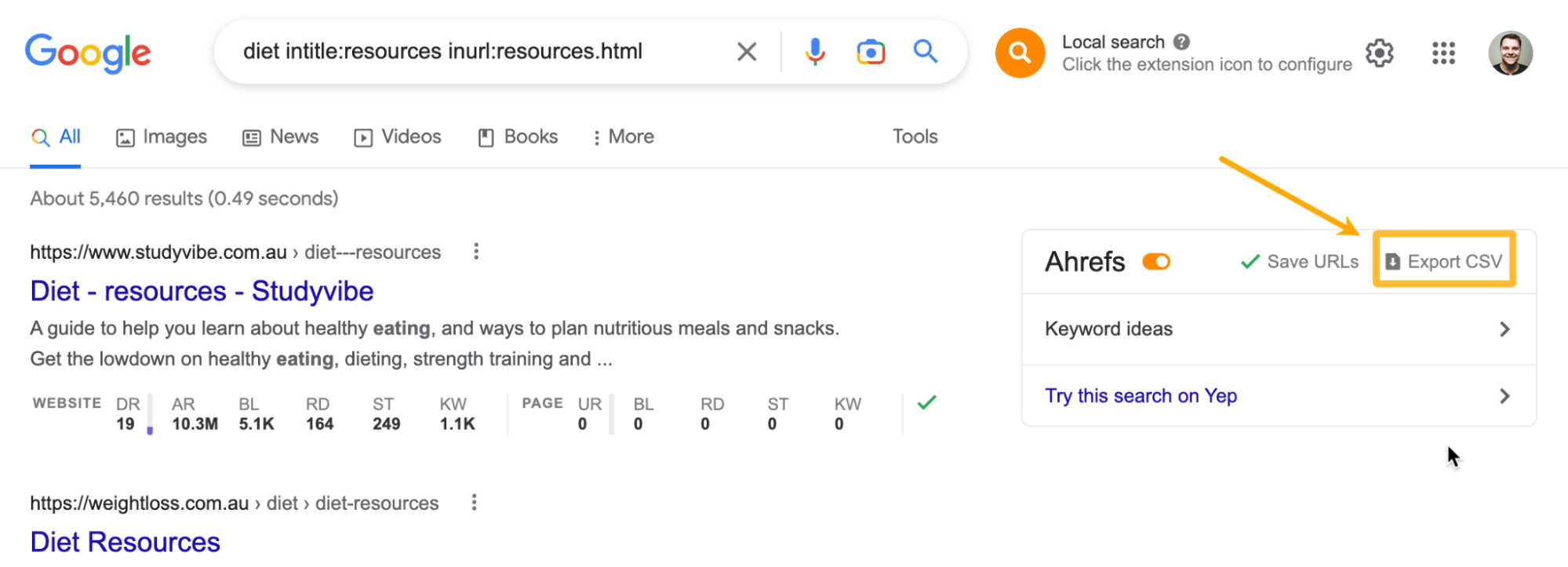
You can then repeat the process for other similar search operators to find more pages, such as:
- fitness intitle:resources inurl:links.html
- fitness intitle:links inurl: resources.html
- fitness inurl:.com/resources
- fitness inurl:resources intitle:resources
Sidenote.
Make sure to change the keyword to something relevant to your resource. It’s also best to keep it quite broad, as you’ll struggle to find relevant results if you go too niche.
If you want even more search operators, use this Google sheet. All you have to do is add up to 10 keywords in the highlighted cells, then head over to the “Results” tab where you’ll have hundreds of search operators ready to go.
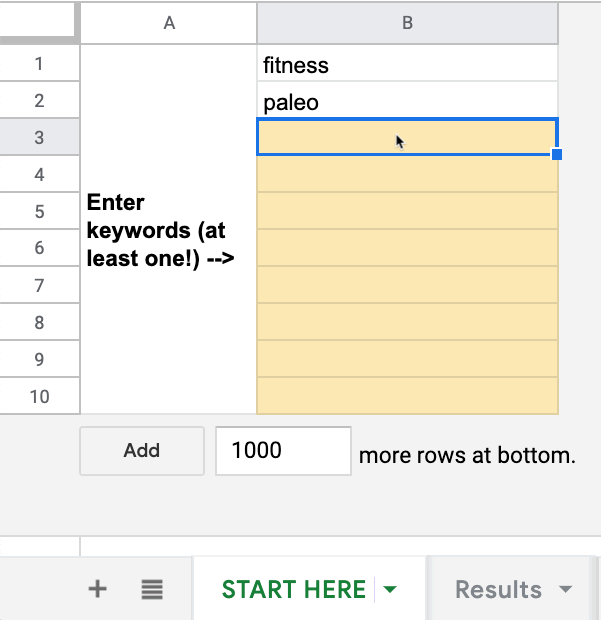
Finally, you can merge all the exported CSVs using this website.
Time-saving tip
If this process sounds like too much hard work, fill in the Google sheet with your keywords and send them to your virtual assistant along with these instructions:
- Install Ahrefs’ SEO Toolbar
- Open this Google sheet: [insert link]
- Click the first link “SERP link” in the tab labeled “Results”
- Click the “Export CSV” button on the Ahrefs overlay in the search results
- Repeat this for the other operators in the sheet
- Use this website to merge the CSVs into one
- Send the final “master” CSV file to me, and bill for your time 🙂
Or, if you prefer an automated solution, use a tool like ScrapeBox or Citation Labs Link Prospector. Just keep in mind that neither of these are free. You’ll need proxies for ScrapeBox, and scrapes in Citation Labs cost $1–$5 a pop.
2. Vet the pages
Not all of the results you scraped from Google will be relevant, so you need to vet them before reaching out. This is a two-step process:
- Filter and eliminate using metrics
- Manually review the remaining pages
A. Filter and eliminate using metrics
You’ve probably got far too many pages on your list to realistically vet by hand, but luckily you can weed out most of the junk with SEO metrics.
Follow this flowchart to find the easiest way to get these metrics for you:
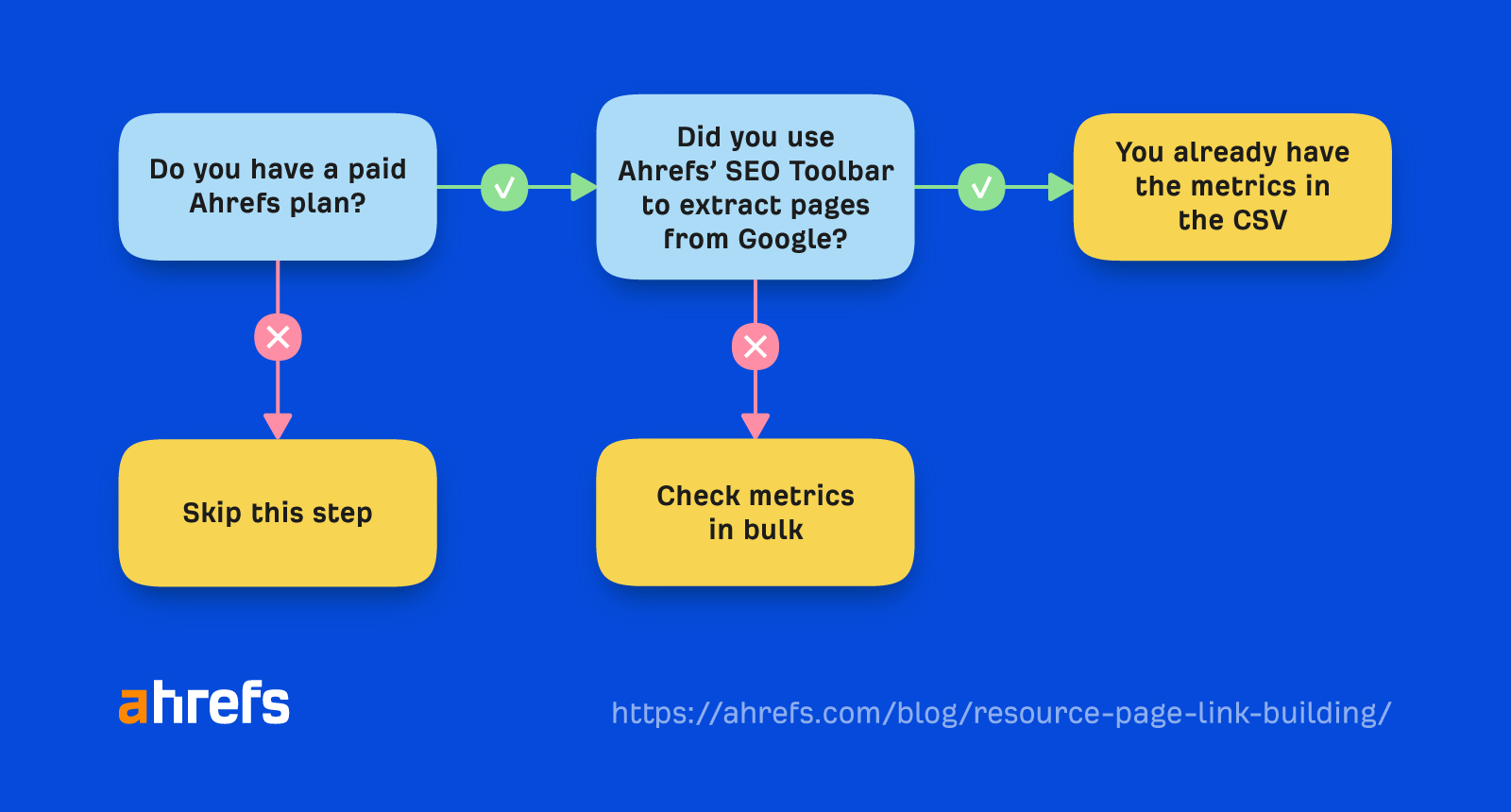
As the flowchart explains, if you have a paid Ahrefs plan and used our SEO Toolbar to extract Google’s results, the metrics are already in your CSV.

If not, there are two options:
Once you’ve pulled the metrics, you can just filter the spreadsheet for prospects that match your requirements. If you’re not sure where to start, here’s my suggestion:
- Domain Rating (DR) >= 10
- Domain Search Traffic (ST): >= 5000
This should be enough to cut the list down by around 70%.
Sidenote.
You can also filter the URL column to remove pages from certain websites, like Twitter or Facebook.
B. Manually review the remaining pages
The easiest way to do this is to open the remaining URLs in batches of five to 10 and review the pages manually. You can use openallurls.com to make this easier.
This process is a bit subjective, but you’re basically looking for pages that:
- Link out to external resources.
- Link to other topically related resources.
- Look like someone cares about maintaining them.
But most importantly, you should look to identify the pages where the addition of your link will add value. Make an effort to do that, and your conversion rate will skyrocket.
For any prospects that don’t meet your requirements, put an “x” in the URL/target column to signify that you don’t need to pitch them.

3. Reach out and suggest your resource
Lastly, you need to find the person responsible for maintaining each resource page and let them know your content exists.
That goes something like this:
- Hey, [Name].
- Just came across your list of resources here: https://ahrefs.com/blog/resource-page-link-building/.
- We just created [x].
- It might make a worthwhile addition to the page.
Sidenote.
I’ve purposely paraphrased this template to encourage you to add your own creative flair.
Here are a few tips to get the most from your efforts:
Tip 1. Respect their preferred contact method
Mail merges are your friend when it comes to doing email outreach at scale. But you shouldn’t ignore the person’s preferred contact method just to make your life easier.
If someone says you should submit resources using a contact form, respect their wishes.
Tip 2. Email the person responsible for the page
Emailing [email protected] is usually avoidable. It’s what lazy marketers do when they can’t be bothered to hunt down a real person’s email address.
Don’t be that marketer. Make an effort to figure out who’s responsible for the page and contact them directly. Your conversion rate will thank you for it.
Tip 3. Tell them where the link should go
Links on resource pages are often divided into subgroups. Don’t hesitate to tell the recipient where you think your resource should be placed. It’s helpful.
Tip 4. Point out broken links on the page
Broken links on a resource page are yet another incentive for the site owner to edit them. And if they’re doing that, they may as well add your resource while they’re there.
Here’s an easy (and free) way to check for dead links on a page:
- Go to “Outgoing links” on Ahrefs’ SEO Toolbar
- Click “Check status”

You can then filter for broken links and export them.
It’s then just a case of letting the site owner know about the dead links in your email.
Tip
If you’re using Screaming Frog and want to make this process more efficient, just hit Bulk Export > Response codes > External Links > External Client Error (4xx) Inlinks.
You can then work some spreadsheet magic (VLOOKUP, QUERY) to pull this data into your master prospecting file. That makes it easy to templatize outreach emails using custom mail-merge fields in popular outreach tools like BuzzStream, Pitchbox, and Mailshake.
Tip 5. Don’t pay
Buying links is against Google’s guidelines. Plus, if someone is selling links on a resource page, chances are the page will be pretty useless and spammy.
Follow all of the instructions above, and it should be enough to land at least a handful of resource page links in most niches. But why stop there? There are plenty of other ways to find even more resource pages.
Here are three of them:
1. Search the backlink profiles of sites with known resource page links
Given that resource page link building is a common link building tactic, if a page has a link from one resource page, it probably has links from other resource pages.
Here’s how to find those resource pages:
- Crawl your vetted list of resource pages with Screaming Frog
- Go to Bulk Export > Links > External Links
- Open the CSV and copy all URLs in the “Destination” column
- Paste them into this Google sheet
- Go to the “Results” tab
You should now see a list of websites that have at least one resource page backlink:
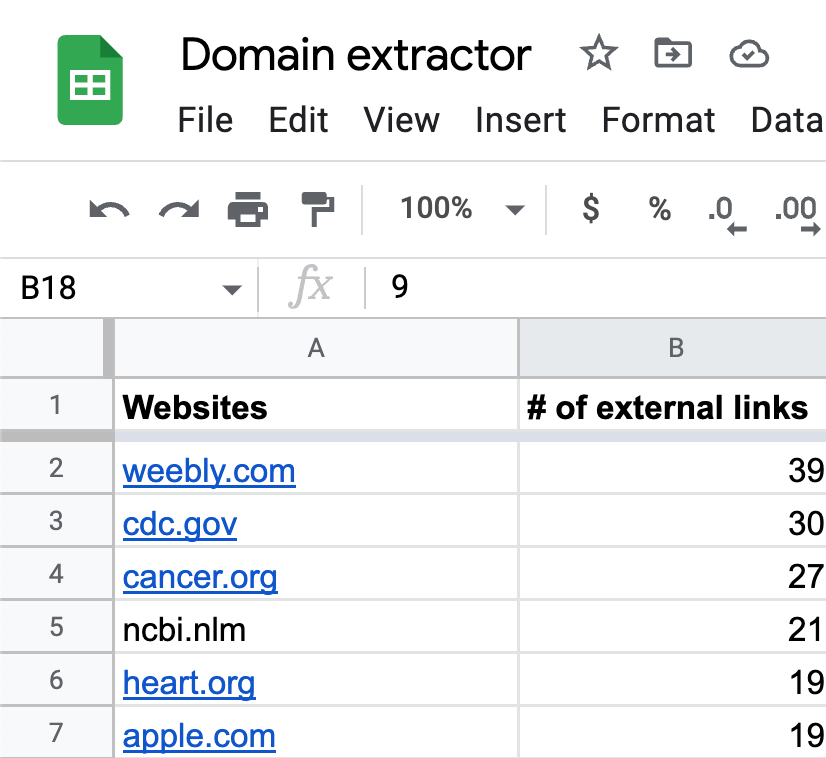
From here, you can simply paste any relevant domains into Ahrefs’ Site Explorer, go to the Backlinks report, and search for “resources.htm” in the referring page URL.
For example, if we do this for eatright.org, we get 344 results:
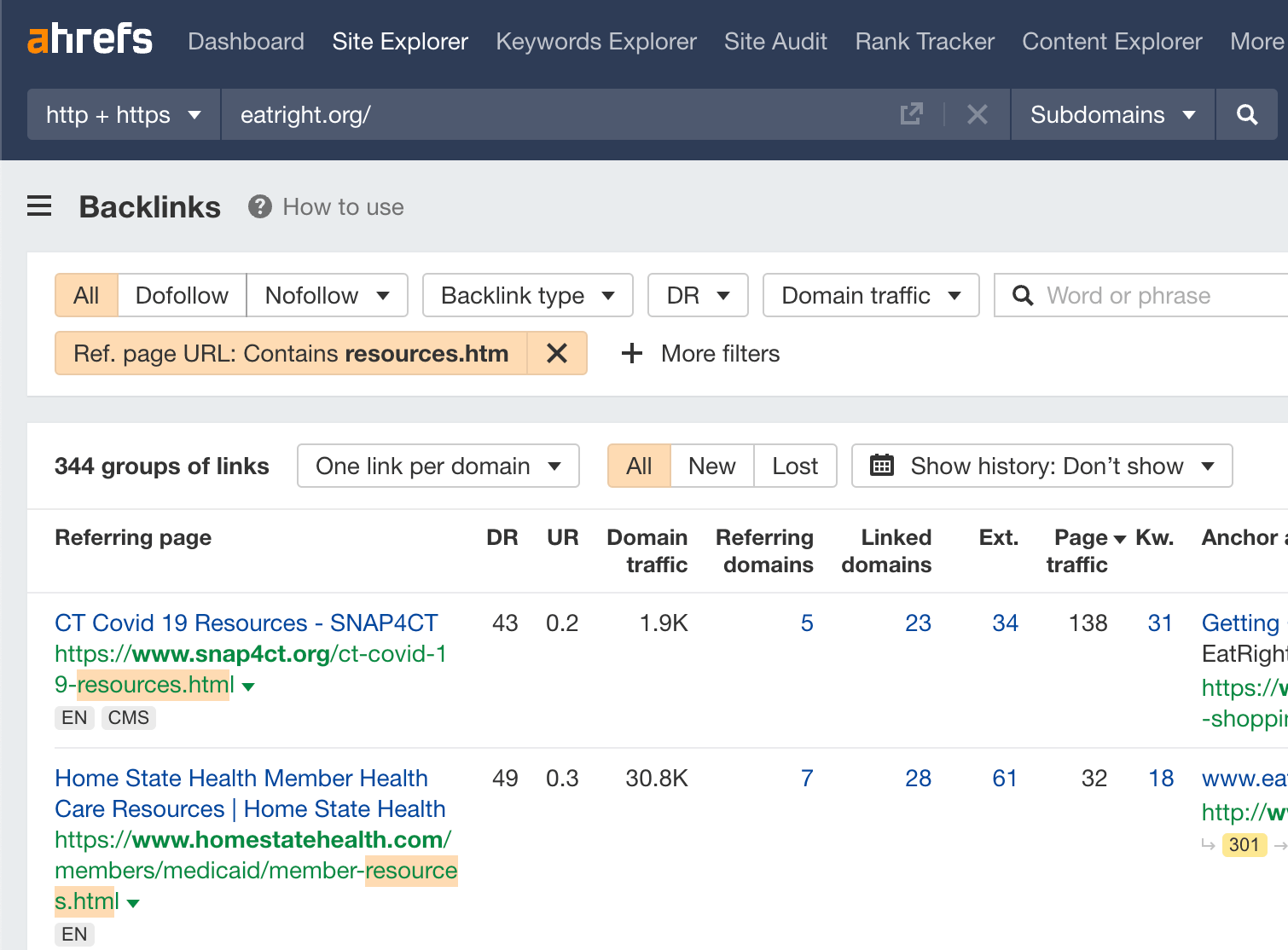
Here’s just one example:

2. Search for listicle resource pages
Most “traditional” resource page search operators won’t find listicles like this:
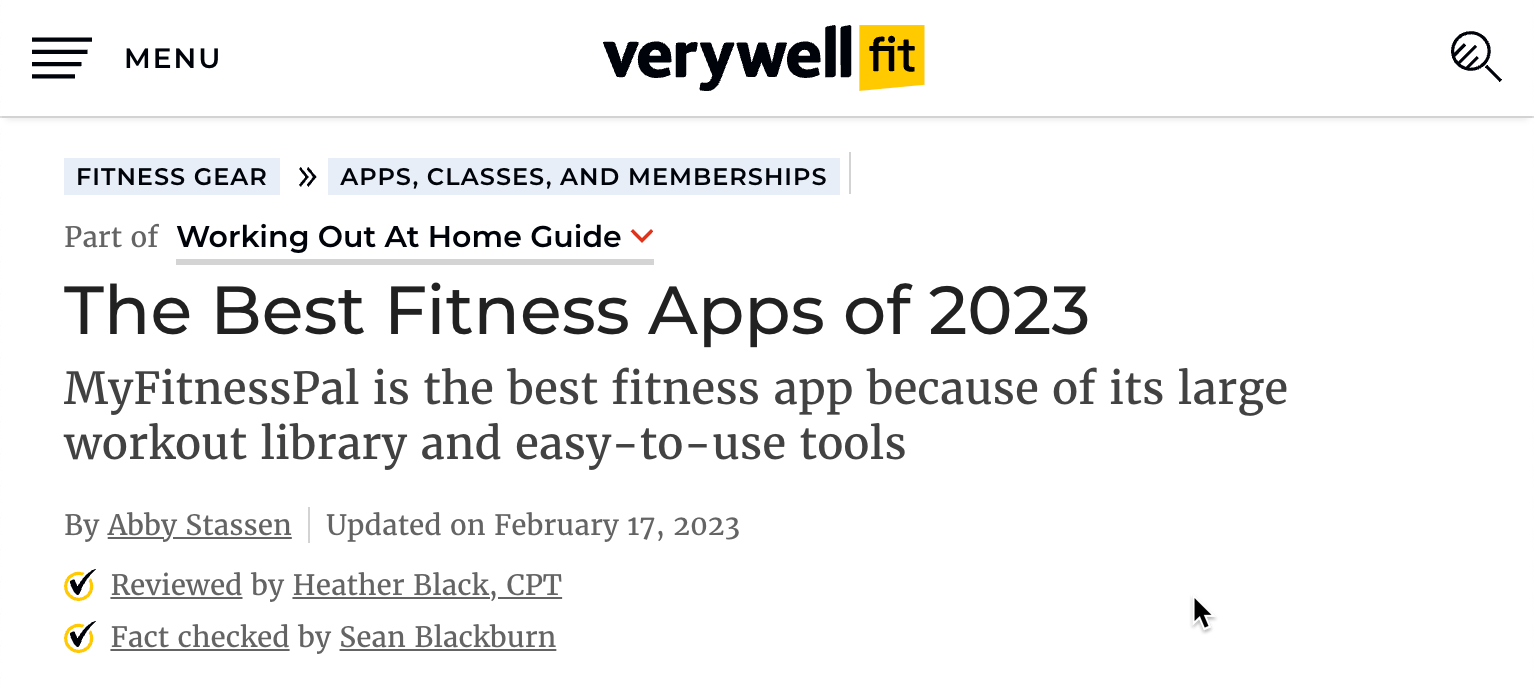
That’s a shame because these are also “resource” pages in their own right, as they list and link useful resources.
To find these pages, just search Google for “best [thing]”.
For example, if you run a gym in London, you could simply search for “best gyms in london”:
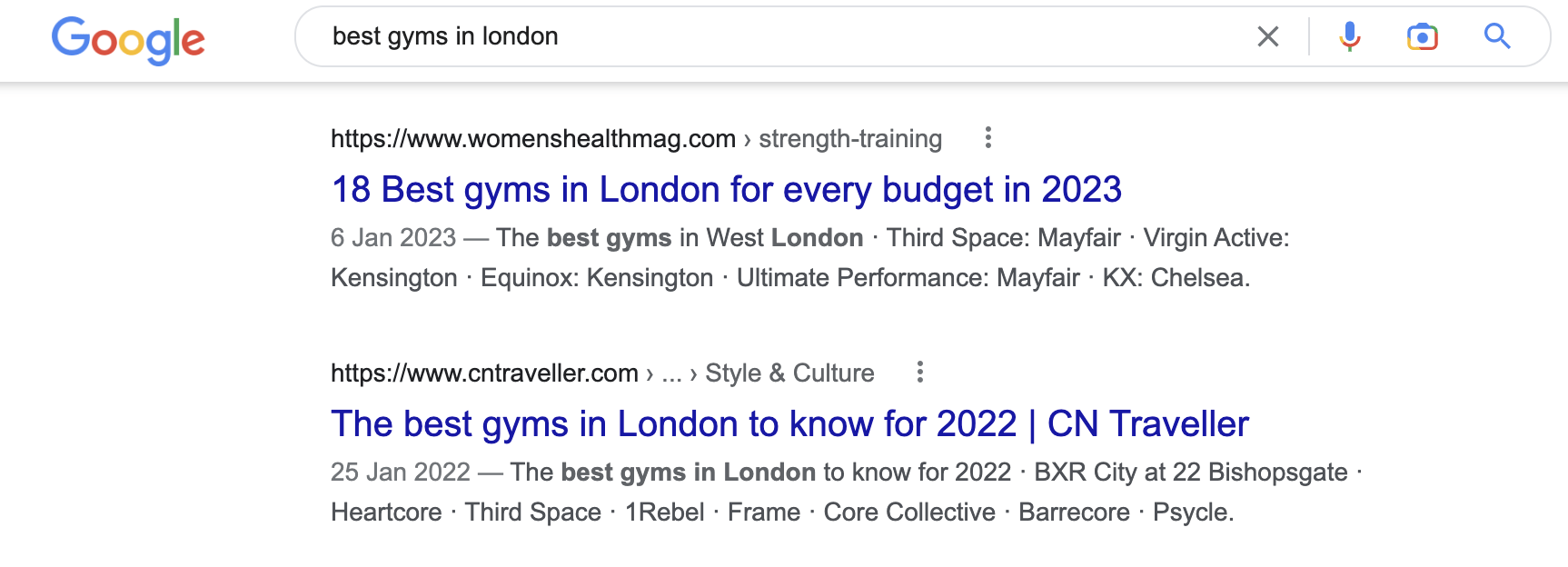
You can then use Ahrefs’ SEO Toolbar to extract these to a CSV file (along with SEO metrics, for paying customers).
If you’re an Ahrefs user, you can speed up your search using Content Explorer. Just run an “In title” search and filter for pages that match your criteria (e.g., DR 30+).

Or if you prefer, plug a competitor into Site Explorer, go to the Backlinks report, and search for referring pages with “best [thing]” in their titles.

3. Search for pages with resource sections
Not all resource pages are pages dedicated solely to listing resources.
For example, many of our blog posts have “further reading” sections where we list and link to related resources from other websites:

Here are the search operators you can use to find these opportunities:
- Keyword “further reading”
- Keyword “more resources”
- Keyword “other resources”
- Keyword “favorite resources”
- Keyword “favorite tools”
Then it’s just a case of opening each search result, using CTRL/CMD+F to search for the footprint on the page, and checking that they link to external resources in the section (not just internal resources).
If the opportunity looks promising, find the site owner’s email address and pitch your resource.
Here are the pros and cons of pitching these types of pages:
| Pros | Cons |
|---|---|
| Fewer people are doing it (less competitive). | Not as many of these pages around. |
| Links are often higher quality than “traditional” resource pages. | Their creators aren’t looking for suggestions or feedback, which may mean lower conversion rate. |
If you can build a relationship with the site owner or at least help in some way before pitching, you can overcome some of the cons above.
Final thoughts
Resource page link building is about as straightforward as it gets. That’s probably why so many SEO professionals continue to use this tactic—even in a world of skyscrapers and shotguns.
Want a quick recap of everything we covered? Watch this video:
Got questions? Give me a shout on Twitter.
SEO
How To Write ChatGPT Prompts To Get The Best Results

ChatGPT is a game changer in the field of SEO. This powerful language model can generate human-like content, making it an invaluable tool for SEO professionals.
However, the prompts you provide largely determine the quality of the output.
To unlock the full potential of ChatGPT and create content that resonates with your audience and search engines, writing effective prompts is crucial.
In this comprehensive guide, we’ll explore the art of writing prompts for ChatGPT, covering everything from basic techniques to advanced strategies for layering prompts and generating high-quality, SEO-friendly content.
Writing Prompts For ChatGPT
What Is A ChatGPT Prompt?
A ChatGPT prompt is an instruction or discussion topic a user provides for the ChatGPT AI model to respond to.
The prompt can be a question, statement, or any other stimulus to spark creativity, reflection, or engagement.
Users can use the prompt to generate ideas, share their thoughts, or start a conversation.
ChatGPT prompts are designed to be open-ended and can be customized based on the user’s preferences and interests.
How To Write Prompts For ChatGPT
Start by giving ChatGPT a writing prompt, such as, “Write a short story about a person who discovers they have a superpower.”
ChatGPT will then generate a response based on your prompt. Depending on the prompt’s complexity and the level of detail you requested, the answer may be a few sentences or several paragraphs long.
Use the ChatGPT-generated response as a starting point for your writing. You can take the ideas and concepts presented in the answer and expand upon them, adding your own unique spin to the story.
If you want to generate additional ideas, try asking ChatGPT follow-up questions related to your original prompt.
For example, you could ask, “What challenges might the person face in exploring their newfound superpower?” Or, “How might the person’s relationships with others be affected by their superpower?”
Remember that ChatGPT’s answers are generated by artificial intelligence and may not always be perfect or exactly what you want.
However, they can still be a great source of inspiration and help you start writing.
Must-Have GPTs Assistant
I recommend installing the WebBrowser Assistant created by the OpenAI Team. This tool allows you to add relevant Bing results to your ChatGPT prompts.
This assistant adds the first web results to your ChatGPT prompts for more accurate and up-to-date conversations.
It is very easy to install in only two clicks. (Click on Start Chat.)
For example, if I ask, “Who is Vincent Terrasi?,” ChatGPT has no answer.
With WebBrower Assistant, the assistant creates a new prompt with the first Bing results, and now ChatGPT knows who Vincent Terrasi is.
 Screenshot from ChatGPT, March 2023
Screenshot from ChatGPT, March 2023You can test other GPT assistants available in the GPTs search engine if you want to use Google results.
Master Reverse Prompt Engineering
ChatGPT can be an excellent tool for reverse engineering prompts because it generates natural and engaging responses to any given input.
By analyzing the prompts generated by ChatGPT, it is possible to gain insight into the model’s underlying thought processes and decision-making strategies.
One key benefit of using ChatGPT to reverse engineer prompts is that the model is highly transparent in its decision-making.
This means that the reasoning and logic behind each response can be traced, making it easier to understand how the model arrives at its conclusions.
Once you’ve done this a few times for different types of content, you’ll gain insight into crafting more effective prompts.
Prepare Your ChatGPT For Generating Prompts
First, activate the reverse prompt engineering.
- Type the following prompt: “Enable Reverse Prompt Engineering? By Reverse Prompt Engineering I mean creating a prompt from a given text.”
 Screenshot from ChatGPT, March 2023
Screenshot from ChatGPT, March 2023ChatGPT is now ready to generate your prompt. You can test the product description in a new chatbot session and evaluate the generated prompt.
- Type: “Create a very technical reverse prompt engineering template for a product description about iPhone 11.”
 Screenshot from ChatGPT, March 2023
Screenshot from ChatGPT, March 2023The result is amazing. You can test with a full text that you want to reproduce. Here is an example of a prompt for selling a Kindle on Amazon.
- Type: “Reverse Prompt engineer the following {product), capture the writing style and the length of the text :
product =”
 Screenshot from ChatGPT, March 2023
Screenshot from ChatGPT, March 2023I tested it on an SEJ blog post. Enjoy the analysis – it is excellent.
- Type: “Reverse Prompt engineer the following {text}, capture the tone and writing style of the {text} to include in the prompt :
text = all text coming from https://www.searchenginejournal.com/google-bard-training-data/478941/”
 Screenshot from ChatGPT, March 2023
Screenshot from ChatGPT, March 2023But be careful not to use ChatGPT to generate your texts. It is just a personal assistant.
Go Deeper
Prompts and examples for SEO:
- Keyword research and content ideas prompt: “Provide a list of 20 long-tail keyword ideas related to ‘local SEO strategies’ along with brief content topic descriptions for each keyword.”
- Optimizing content for featured snippets prompt: “Write a 40-50 word paragraph optimized for the query ‘what is the featured snippet in Google search’ that could potentially earn the featured snippet.”
- Creating meta descriptions prompt: “Draft a compelling meta description for the following blog post title: ’10 Technical SEO Factors You Can’t Ignore in 2024′.”
Important Considerations:
- Always Fact-Check: While ChatGPT can be a helpful tool, it’s crucial to remember that it may generate inaccurate or fabricated information. Always verify any facts, statistics, or quotes generated by ChatGPT before incorporating them into your content.
- Maintain Control and Creativity: Use ChatGPT as a tool to assist your writing, not replace it. Don’t rely on it to do your thinking or create content from scratch. Your unique perspective and creativity are essential for producing high-quality, engaging content.
- Iteration is Key: Refine and revise the outputs generated by ChatGPT to ensure they align with your voice, style, and intended message.
Additional Prompts for Rewording and SEO:
– Rewrite this sentence to be more concise and impactful.
– Suggest alternative phrasing for this section to improve clarity.
– Identify opportunities to incorporate relevant internal and external links.
– Analyze the keyword density and suggest improvements for better SEO.
Remember, while ChatGPT can be a valuable tool, it’s essential to use it responsibly and maintain control over your content creation process.
Experiment And Refine Your Prompting Techniques
Writing effective prompts for ChatGPT is an essential skill for any SEO professional who wants to harness the power of AI-generated content.
Hopefully, the insights and examples shared in this article can inspire you and help guide you to crafting stronger prompts that yield high-quality content.
Remember to experiment with layering prompts, iterating on the output, and continually refining your prompting techniques.
This will help you stay ahead of the curve in the ever-changing world of SEO.
More resources:
Featured Image: Tapati Rinchumrus/Shutterstock
SEO
Measuring Content Impact Across The Customer Journey

Understanding the impact of your content at every touchpoint of the customer journey is essential – but that’s easier said than done. From attracting potential leads to nurturing them into loyal customers, there are many touchpoints to look into.
So how do you identify and take advantage of these opportunities for growth?
Watch this on-demand webinar and learn a comprehensive approach for measuring the value of your content initiatives, so you can optimize resource allocation for maximum impact.
You’ll learn:
- Fresh methods for measuring your content’s impact.
- Fascinating insights using first-touch attribution, and how it differs from the usual last-touch perspective.
- Ways to persuade decision-makers to invest in more content by showcasing its value convincingly.
With Bill Franklin and Oliver Tani of DAC Group, we unravel the nuances of attribution modeling, emphasizing the significance of layering first-touch and last-touch attribution within your measurement strategy.
Check out these insights to help you craft compelling content tailored to each stage, using an approach rooted in first-hand experience to ensure your content resonates.
Whether you’re a seasoned marketer or new to content measurement, this webinar promises valuable insights and actionable tactics to elevate your SEO game and optimize your content initiatives for success.
View the slides below or check out the full webinar for all the details.
SEO
How to Find and Use Competitor Keywords

Competitor keywords are the keywords your rivals rank for in Google’s search results. They may rank organically or pay for Google Ads to rank in the paid results.
Knowing your competitors’ keywords is the easiest form of keyword research. If your competitors rank for or target particular keywords, it might be worth it for you to target them, too.
There is no way to see your competitors’ keywords without a tool like Ahrefs, which has a database of keywords and the sites that rank for them. As far as we know, Ahrefs has the biggest database of these keywords.
How to find all the keywords your competitor ranks for
- Go to Ahrefs’ Site Explorer
- Enter your competitor’s domain
- Go to the Organic keywords report
The report is sorted by traffic to show you the keywords sending your competitor the most visits. For example, Mailchimp gets most of its organic traffic from the keyword “mailchimp.”


Since you’re unlikely to rank for your competitor’s brand, you might want to exclude branded keywords from the report. You can do this by adding a Keyword > Doesn’t contain filter. In this example, we’ll filter out keywords containing “mailchimp” or any potential misspellings:


If you’re a new brand competing with one that’s established, you might also want to look for popular low-difficulty keywords. You can do this by setting the Volume filter to a minimum of 500 and the KD filter to a maximum of 10.


How to find keywords your competitor ranks for, but you don’t
- Go to Competitive Analysis
- Enter your domain in the This target doesn’t rank for section
- Enter your competitor’s domain in the But these competitors do section


Hit “Show keyword opportunities,” and you’ll see all the keywords your competitor ranks for, but you don’t.


You can also add a Volume and KD filter to find popular, low-difficulty keywords in this report.


How to find keywords multiple competitors rank for, but you don’t
- Go to Competitive Analysis
- Enter your domain in the This target doesn’t rank for section
- Enter the domains of multiple competitors in the But these competitors do section


You’ll see all the keywords that at least one of these competitors ranks for, but you don’t.


You can also narrow the list down to keywords that all competitors rank for. Click on the Competitors’ positions filter and choose All 3 competitors:


- Go to Ahrefs’ Site Explorer
- Enter your competitor’s domain
- Go to the Paid keywords report


This report shows you the keywords your competitors are targeting via Google Ads.
Since your competitor is paying for traffic from these keywords, it may indicate that they’re profitable for them—and could be for you, too.
You know what keywords your competitors are ranking for or bidding on. But what do you do with them? There are basically three options.
1. Create pages to target these keywords
You can only rank for keywords if you have content about them. So, the most straightforward thing you can do for competitors’ keywords you want to rank for is to create pages to target them.
However, before you do this, it’s worth clustering your competitor’s keywords by Parent Topic. This will group keywords that mean the same or similar things so you can target them all with one page.
Here’s how to do that:
- Export your competitor’s keywords, either from the Organic Keywords or Content Gap report
- Paste them into Keywords Explorer
- Click the “Clusters by Parent Topic” tab


For example, MailChimp ranks for keywords like “what is digital marketing” and “digital marketing definition.” These and many others get clustered under the Parent Topic of “digital marketing” because people searching for them are all looking for the same thing: a definition of digital marketing. You only need to create one page to potentially rank for all these keywords.


2. Optimize existing content by filling subtopics
You don’t always need to create new content to rank for competitors’ keywords. Sometimes, you can optimize the content you already have to rank for them.
How do you know which keywords you can do this for? Try this:
- Export your competitor’s keywords
- Paste them into Keywords Explorer
- Click the “Clusters by Parent Topic” tab
- Look for Parent Topics you already have content about
For example, if we analyze our competitor, we can see that seven keywords they rank for fall under the Parent Topic of “press release template.”


If we search our site, we see that we already have a page about this topic.


If we click the caret and check the keywords in the cluster, we see keywords like “press release example” and “press release format.”


To rank for the keywords in the cluster, we can probably optimize the page we already have by adding sections about the subtopics of “press release examples” and “press release format.”
3. Target these keywords with Google Ads
Paid keywords are the simplest—look through the report and see if there are any relevant keywords you might want to target, too.
For example, Mailchimp is bidding for the keyword “how to create a newsletter.”


If you’re ConvertKit, you may also want to target this keyword since it’s relevant.
If you decide to target the same keyword via Google Ads, you can hover over the magnifying glass to see the ads your competitor is using.


You can also see the landing page your competitor directs ad traffic to under the URL column.


Learn more
Check out more tutorials on how to do competitor keyword analysis:
-

 PPC6 days ago
PPC6 days ago19 Best SEO Tools in 2024 (For Every Use Case)
-

 MARKETING7 days ago
MARKETING7 days agoEcommerce evolution: Blurring the lines between B2B and B2C
-
SEARCHENGINES5 days ago
Daily Search Forum Recap: April 19, 2024
-
SEARCHENGINES6 days ago
Daily Search Forum Recap: April 18, 2024
-

 WORDPRESS5 days ago
WORDPRESS5 days agoHow to Make $5000 of Passive Income Every Month in WordPress
-

 SEO6 days ago
SEO6 days ago2024 WordPress Vulnerability Report Shows Errors Sites Keep Making
-

 WORDPRESS6 days ago
WORDPRESS6 days ago10 Amazing WordPress Design Resouces – WordPress.com News
-
WORDPRESS7 days ago
[GET] The7 Website And Ecommerce Builder For WordPress
















You must be logged in to post a comment Login